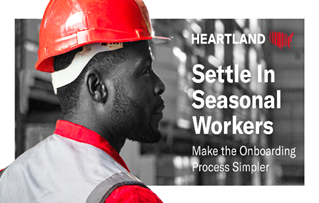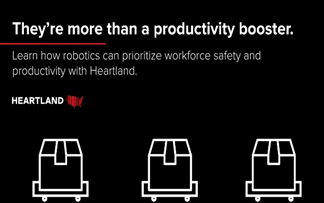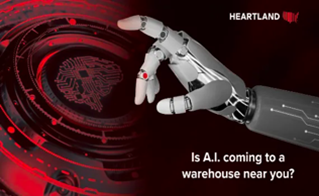
3 Ways to Empower Faster Employee Onboarding
Feb 27, 2024
The past few years have been a whirlwind—including years of consistent high demand, inconsistencies in the supply chain, and less consumer spending. As a result, many companies have been left with abundances in leftover inventory and drastically increased costs that hinder profitability. Many businesses have run into challenges when trying to maintain full time employees. In effort to combat these challenges, businesses have started to seek out effective alternatives—more automation, for example. Focusing on increased automation within businesses, it is clear to see that not only does it benefit the business, as a whole, it enables a faster employee onboarding process, a seamless training process, increased company efficiency across the board, and decreased occurrences of work-related injuries—all promoting a smoother, safer, and more efficient business. At Heartland, our solutions are centered around bringing these benefits to you in the form of second-to-none ROIs.
- Improved Employee Training – As many already know, manual employee onboarding is a strenuously long process that can jumpstart countless problems for both the new hire and the hiring company, respectively. Of the many issues, the one that reigns supreme is the fact that this process is extremely time-consuming for any staff, as it requires piles of paperwork and many other logistical tasks. Such tedious endeavors take away their focus from more strategic-based tasks, such as managing and developing employees. In these struggles lies the very real possibility of human error taking place, too. Through manual onboarding, detrimental occurrences like missed deadlines, incomplete tasks, and overall inconsistencies can take place. It is with these numerous complications in mind that we see that a vast majority of decision-makers in all sectors of business and associates, alike, agree that training and learning can be improved through technology. Additionally, many retailers believe that they should invest resources into technological-based training methods and materials. By investing in such materials and directly training new hires in the technology they’ll be using for their work, onboarding times will be shortened greatly, and a stronger employee connection is created. Not only that, but businesses will also save money by not needing to hire specific training associates. Having new hires trained in the technology they will use in their everyday lives at work produces more competent and skilled employees, which creates an improved, more efficient, working environment—increasing employee retention, too.

Related: How to Simplify Onboarding for Your Seasonal Team - Decreased work-related injuries – Per the Bureau of Labor Statistics, in 2021, private employers of all industries in the United States recorded over 5,000 work-related injuries that turned out to be fatal as well as over 2.6 million work-related illnesses and injuries that were not fatal. Because of these illnesses and injuries, an estimated total cost for all of those who were involved was a staggering $167 billion, which is the equivalent to around 3.5% of the United States’ government budget outlays in 2021. Other studies have indicated that companies pay nearly $150,000 per work-related incident. Similarly, in the manufacturing sector alone, around 370,000 injuries were recorded. On average, these incidents stemmed from a variety of reasons, including: overexertion, contact with an object, bodily reactions of some kind, falls, trips, and slips, as well as accidents in transportation. Along with these factors, work-related accidents can also be caused by complacency, frustration, rushing, fatigue, and inattention. It is through these kinds of incidents that the benefits of automated solutions in the workplace shine the brightest. The use of robots, for example, in jobs—in manufacturing as well as all sectors of business, alike—that are dangerous, dirty, and/or difficult may reduce the risks that are affiliated with complacency and the innate hazards of demanding, repetitive tasks. Then, in an industrial setting, robots can be utilized to carry out physically intense or dangerous tasks which are usually grouped together with higher occurrence of injuries and damaging effects on employees’ health. Further emphasizing the benefits of automation to employee health, according to a study conducted by Gunadi and Ryu, it is clear that an increase of 10% in robots per 1,000 human employees equated to a 10% decline in front-line employees who report poor physical health. Ultimately, work-related accidents are not only expensive for employers and employees, they also reduce the morale of employees, lower productivity, and magnify training costs.

Related: Robotics and Worker Safety Go Together. Here’s why: - Increased efficiency – Overall, the implementation of robots in the workplace can provide outstanding improvements in efficiency, decreased errors, and enhanced accuracy and productivity. Per Graetz and Michaels, robots added approximately 0.36% growth in yearly labor productivity across the numerous countries they studied. Along with that, such technological integration led to a rise in total factor productivity and lowered prices of outputs. Similar to robotic implementation, the integration of Artificial Intelligence (AI) has the capabilities to reduce risks related to work as well. Through the power of smart technologies, like Artificial Intelligence, businesses are able to monitor employees and machines, as well as label and predict risks. Along with that, they are able to track assets from the minute they are purchased to right when they are disposed of, providing better utilization and decreasing loss—which grants businesses better control over their asset management. Artificial Intelligence can also be utilized to organize dangerous or physically intensive tasks, such as material handling, assembly and disassembly projects, operations involving heavy machinery, and countless others. In doing so, human interaction is limited which, as a result, limits the possibility for human error to take place, too. As a result, the risk of employee injury is decreased, as they become minimally exposed to possible hazards. The algorithms of Artificial Intelligence can also be used to predict safety hazards within the workplace, analyze said hazards, and grant recommendations on possible preventive measures by creating interactive simulations for training materials so that employees can safely practice emergency procedures and responses in a controlled virtual environment. Tracking workplace conditions through Artificial Intelligence optimizes a business across all its sectors.
Related: Does Artificial Intelligence Belong in the Warehouse?
The constant, fast-paced movement of warehouse environments leaves businesses no choice but to put the safety of their employees first through robotic and automated solutions that can lessen the respective pressures on businesses and those employed by them. If you’re looking to hire employees or are interested in safeguarding your warehouse workers through state-of-the-art automated solutions, contact our team today to take a step in the right direction.



